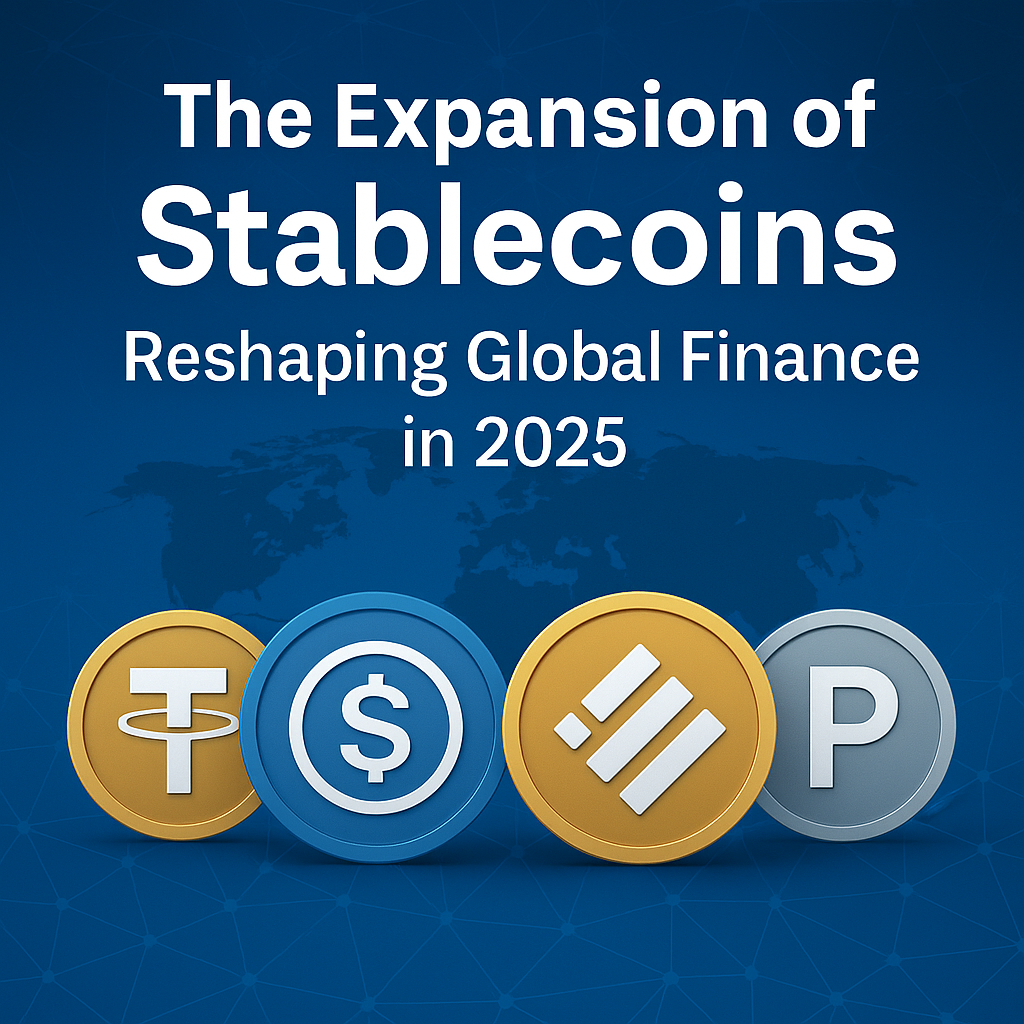Stablecoins have emerged as a cornerstone of the cryptocurrency ecosystem, bridging the gap between the volatility of traditional cryptocurrencies and the stability of fiat currencies. As of June 2025, stablecoins are no longer just a niche tool for crypto traders; they are transforming global commerce, remittances, and financial systems. With daily transfer volumes projected to reach $300 billion by the end of 2025, stablecoins are driving blockchain adoption in both decentralized and traditional finance. This blog explores the factors fueling stablecoin expansion, their real-world applications, challenges, and future potential.
What Are Stablecoins?
Stablecoins are cryptocurrencies designed to maintain a stable value, typically pegged to a fiat currency like the U.S. dollar, a commodity like gold, or a basket of assets. Unlike volatile cryptocurrencies such as Bitcoin or Ethereum, stablecoins aim to minimize price fluctuations, making them ideal for everyday transactions, savings, and financial operations. The most prominent stablecoins include Tether (USDT), USD Coin (USDC), and Binance USD (BUSD), with newer players like PayPal USD (PYUSD) gaining ground.
Stablecoins achieve stability through mechanisms like:
-
Fiat-Collateralized: Backed by reserves of fiat currency or cash equivalents (e.g., USDT, USDC).
-
Crypto-Collateralized: Backed by other cryptocurrencies, often over-collateralized to absorb volatility (e.g., DAI).
-
Algorithmic: Using smart contracts to adjust supply and maintain a stable peg (e.g., TerraUSD before its collapse).
-
Commodity-Backed: Tied to assets like gold or silver (e.g., PAX Gold).
This stability has made stablecoins a critical infrastructure for the crypto economy and beyond.
The Surge in Stablecoin Usage
Stablecoin adoption has skyrocketed in recent years, driven by their utility and growing acceptance in mainstream finance. Key data points highlight this expansion:
-
Market Growth: The total market capitalization of stablecoins surpassed $200 billion in 2024 and is expected to grow further in 2025, with USDT and USDC dominating over 80% of the market.
-
Transfer Volumes: Daily stablecoin transfer volumes are projected to hit $300 billion by the end of 2025, a significant leap from $100 billion in 2023, according to industry reports.
-
Cross-Border Transactions: Stablecoins are revolutionizing remittances, with use cases like U.S.-Mexico transfers expected to grow 5x by 2026 due to lower fees and faster settlement compared to traditional systems like SWIFT.
-
DeFi Integration: Stablecoins are the backbone of decentralized finance (DeFi), enabling lending, borrowing, and trading on platforms like Aave, Curve, and Uniswap. Over 60% of DeFi’s total value locked (TVL), expected to exceed $200 billion in 2025, is held in stablecoins.
Key Drivers of Stablecoin Expansion
Several factors are propelling the rapid growth of stablecoins:
1. Regulatory Clarity in the U.S.
The pro-crypto stance of the U.S. administration in 2025 has created a favorable environment for stablecoins. The abandonment of lawsuits against major crypto exchanges and proposed legislation, such as the Clarity for Payment Stablecoins Act, have provided issuers with clearer guidelines. This regulatory tailwind is encouraging institutional adoption and fostering trust among users.
For example, major financial institutions like JPMorgan and PayPal are expanding their stablecoin offerings, with PYUSD gaining traction for e-commerce and cross-border payments. The U.S. Treasury’s support for stablecoins as a tool for financial inclusion has further legitimized their role.
2. Mainstream Adoption in Global Commerce
Stablecoins are moving beyond crypto trading into real-world applications. Retail giants, payment processors, and fintech companies are integrating stablecoins for seamless transactions. For instance:
-
Remittances: In regions like Latin America and Southeast Asia, stablecoins like USDC are reducing remittance costs from 6-7% (via traditional systems) to under 1%. This is particularly impactful for migrant workers sending money home.
-
E-Commerce: Platforms like Shopify and WooCommerce now support stablecoin payments, enabling merchants to accept USDT or USDC with near-instant settlement.
-
Micropayments: Content creators and freelancers are using stablecoins for small, cross-border payments, bypassing high fees charged by traditional payment processors.
3. DeFi and Tokenization Synergies
Stablecoins are integral to DeFi, where they serve as a stable medium of exchange and store of value. The tokenization of real-world assets (RWAs), such as real estate and private credit, is another growth driver. In 2024, tokenized assets grew by over 60% to $13.5 billion, with stablecoins facilitating these transactions on blockchain platforms. For example, stablecoins are used to settle tokenized bond payments or real estate deals, streamlining processes and reducing intermediaries.
4. Central Bank Digital Currencies (CBDCs) and Stablecoin Coexistence
Over 130 countries are exploring CBDCs to modernize payment systems, and stablecoins are complementing these efforts. Unlike CBDCs, which are centralized and government-controlled, stablecoins offer decentralized alternatives that prioritize privacy and accessibility. For instance, stablecoins are being used in regions with limited banking infrastructure, providing financial services to the unbanked.
5. Technological Advancements
Layer-2 scaling solutions like Arbitrum and Optimism have reduced transaction costs and increased the speed of stablecoin transfers. For example, USDC on Ethereum’s layer-2 networks can process transactions for fractions of a cent, making stablecoins viable for everyday use. Cross-chain interoperability, enabled by protocols like Chainlink CCIP, allows stablecoins to move seamlessly across blockchains, enhancing their utility.
Real-World Applications of Stablecoins
Stablecoins are reshaping industries with their versatility:
-
Remittances and Cross-Border Payments: Stablecoins enable near-instant, low-cost international transfers. In 2025, companies like Stellar and Ripple are leveraging USDC and XRP-based stablecoins to facilitate remittances, particularly in developing nations.
-
DeFi Lending and Borrowing: Platforms like Aave and Compound use stablecoins to offer loans with predictable interest rates, attracting both retail and institutional users.
-
Payroll and Freelancing: Companies like Bitwage are using stablecoins to pay remote workers globally, reducing delays and currency conversion costs.
-
Supply Chain Finance: Stablecoins streamline payments in global supply chains, enabling real-time settlements between suppliers and manufacturers.
-
Charity and Aid: Organizations like UNICEF are using stablecoins to deliver transparent, trackable aid to disaster-stricken areas, ensuring funds reach recipients directly.
Challenges Facing Stablecoin Expansion
Despite their growth, stablecoins face significant hurdles:
-
Regulatory Risks: While the U.S. is moving toward clearer regulations, global frameworks remain fragmented. Countries like China have banned stablecoin trading, and the EU’s MiCA regulation imposes strict compliance requirements.
-
Reserve Transparency: Concerns persist about the backing of fiat-collateralized stablecoins. Tether, for instance, has faced scrutiny over the composition of its reserves, though it has improved transparency in recent years.
-
Security Risks: Stablecoin smart contracts and custodial wallets are targets for hackers. High-profile exploits, like the $600 million Poly Network hack in 2021, highlight vulnerabilities.
-
De-Pegging Risks: Algorithmic stablecoins, like TerraUSD, have collapsed in the past, causing market-wide panic. Even fiat-backed stablecoins can face temporary de-pegging during extreme market conditions.
-
Competition from CBDCs: As CBDCs gain traction, they could compete with private stablecoins, especially in jurisdictions with strict capital controls.
The Future of Stablecoins
The trajectory of stablecoin expansion points to a transformative role in global finance:
-
Mass Adoption: By 2027, stablecoin transaction volumes could rival those of traditional payment networks like Visa, with projections estimating $1 trillion in annual volume.
-
Integration with Traditional Finance: Banks and fintechs are likely to issue their own stablecoins, blurring the lines between crypto and legacy systems. For example, Societe Generale’s EUR CoinVertible is already used in institutional markets.
-
Interoperability: Advances in blockchain interoperability will make stablecoins more versatile, enabling seamless use across public and private blockchains.
-
Financial Inclusion: Stablecoins will continue to empower the unbanked, particularly in regions with unstable currencies or limited banking access.
-
Innovation in Stablecoin Models: New hybrid models, combining fiat and crypto collateral or integrating AI for dynamic peg management, could emerge to address current limitations.
Conclusion
Stablecoins are at the forefront of the cryptocurrency revolution, offering a stable, efficient, and accessible alternative to traditional financial systems. Their expansion in 2025 is driven by regulatory clarity, technological advancements, and growing real-world applications, from remittances to DeFi and tokenized assets. However, challenges like regulatory uncertainty and security risks remain. As stablecoins continue to evolve, they have the potential to redefine money, making financial systems more inclusive, transparent, and efficient.
For investors, businesses, and individuals, stablecoins represent both opportunity and responsibility. Staying informed about regulatory changes, conducting due diligence on stablecoin issuers, and understanding the risks are crucial steps in navigating this dynamic landscape. As we move deeper into 2025, stablecoins are poised to become a foundational pillar of the global economy, bridging the gap between crypto and traditional finance.
Disclaimer: The cryptocurrency market is highly volatile, and investments carry significant risks. Always conduct thorough research and consult financial advisors before engaging with stablecoins or other crypto assets.
Sources: Insights are drawn from recent industry reports, X posts, and web analyses, including projections from CoinGecko, Chainalysis, and posts on X discussing stablecoin trends. For real-time updates, platforms like X provide valuable sentiment and community insights.


